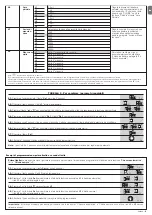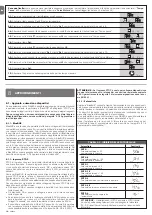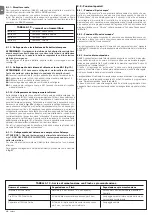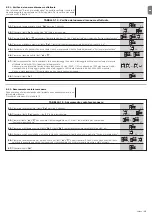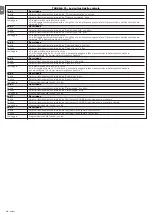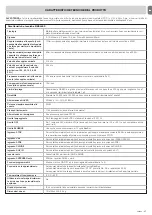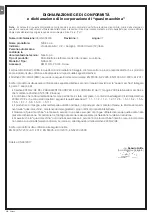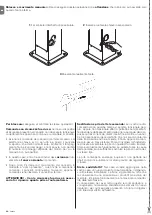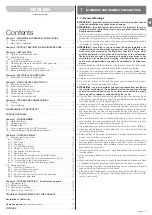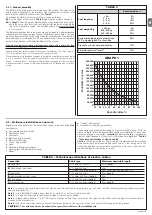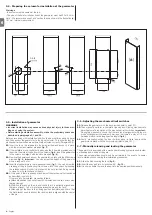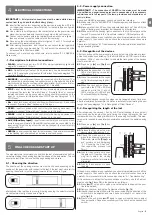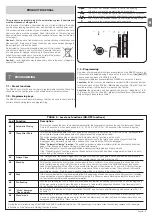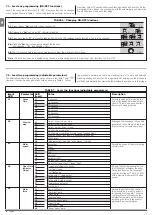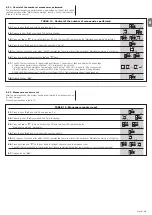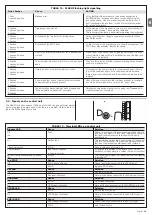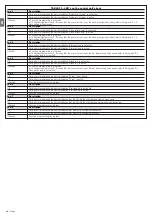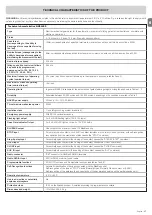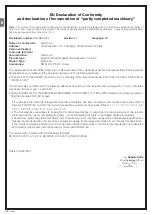
EN
English –
3
3.2
.1
- Product durability
The lifetime is the average economic duration of the product. The value of life-
time is strongly influenced by the intensity of the manoeuvres, i.e. the sum of all
factors that contribute to product wear (see
Table 3
).
To estimate the lifetime of your automation, proceed as follows:
01.
Add the values of the items in
Table 3
regarding the system conditions;
02.
In
Graph 1
from the value obtained above, trace vertical line until it inter-
sects the curve; from this point trace a horizontal line until it intersects the
line of the “manoeuvre cycles”. The obtained value is the estimated lifetime
of your product.
The lifetime values specified in the graph are only obtainable if the maintenance
schedule is strictly observed (see chapter “Maintenance schedule”). The esti-
mation of lifetime is made on the basis of design calculations and the results of
tests performed on prototypes. As it is only an estimation, it does not represent
any form of guarantee on the effective lifetime of the product.
Example of durability calculation: automation of a gate with a door 4.5 m long
with a weight of 250 Kg, installed near the sea:
Table 3 shows the “severity index” for this type of installation: 10% (“Door length”),
15% (“Door weight”) and 15% (“Presence of dust, sand or salt”).
These indicators must be added together to obtain the overall severity index, which
is in this case 40%. With the value identified (40%), look at the horizontal axis of
Graph 1 (“severity index”), and identify the value corresponding to the number of
“manoeuvre cycles” our product will be able to perform in its lifespan, about 105,000
cycles.
TABLE 4 - Technical specifications of electric cables
Connection
Cable type
Maximum admissible length
A
:
Power line
N°1 cable 3 x 1,5 mm
2
30 m (
note 1
)
B
:
Flashing light with aerial
N°1 cable 2x0,5mm
2
20m
N°1 RG58 type shielded cable
20m (recommended less than 5 m)
C
:
Photocells
N°1 cable 2x0,5mm
2
30m (
note 2
)
D
:
Key-operated selector switch
N°2 cables 2x0,5mm
2
(
note 3
) 50m
E
:
Fixed edges
N°1 cable 2x0,5mm
2
(
note 4
) 30m
F
:
Movable edges
N°1 cable 2x0,5mm
2
(
note 4
)
30m (
note 5
)
Note 1
– power supply cable longer than 30 m may be used provided it has a larger gauge, e.g. 3x2,5mm
2
, and that a safety grounding system is provided
near the automation unit.
Note 2
– If the “BLUEBUS” cable is longer than 30 m, up to 50 m, a 2x1mm
2
cable is needed.
Note 3
– A single 2x0,5mm
2
cable can be used instead of two 4x0,5mm
2
cables.
Note 4
– Please refer to Chapter “7.3.2 STOP Input” in situations where there is more than one edge, for information about the type of connection recom-
mended by the manufacturer.
Note 5
– special devices which enable connection even when the leaf is moving must be used to connect movable edges to sliding leaves.
CAUTION!
– The cables used must be suited to the type of environment of the installation site.
0
10 20 30 40 50 60 70 80 90 100
20.000
40.000
60.000
80.000
100.000
120.000
140.000
160.000
180.000
200.000
220.000
240.000
260.000
GRAPH 1
Severity index %
Durability in cycles
Surrounding temperature greater than
40°C or lower than 0°C or humidity
greater than 80%
Presence of dust, sand and salinity
Set motor power to “level 4”
20%
15%
15%
TABLE 3
Severity index %
< 3 m
3 - 4 m
4 - 5 m
5 - 6 m
< 200 kg
200 - 300 kg
300 - 400 kg
0%
5%
10%
20%
0%
15%
30%
Leaf length m
Leaf weight Kg
3.3 - Preliminary installation set-up work
Fig. 2
provides an example of an automation system, produced using
Nice
components:
a
Key-operated selector switch
b
Photocells on post
c
Photocells
d
Main fixed edge (optional)
e
Main movable edge
f
“Open” stop bracket
g
Rack
h
Secondary fixed edge (optional)
i
Flashing light with incorporated aerial
l
Naked
m
“Closed” stop bracket
n
Secondary movable edge (optional)
These parts are positioned according to a typical standard layout. With ref-
erence to
fig. 2
, locate the approximate position for installation of each com-
ponent envisaged in the system.
Important
– Before installation, prepare the
electric cables required for the system, with reference to
fig. 2
and “
Table 4
-
Technical specifications of electric cables
”.
Caution
– When laying the ducting for routing the electrical cables, also take
into account that due to possible deposits of water in the routing ducts, the
connection pipelines must not create condensate in the control unit, with con-
sequent damage to the electronic circuits.
Summary of Contents for Naked Sliding NKSL400
Page 2: ......
Page 43: ...I 405 mm 131 mm 135 mm 1 3 4 5 b d c c h l b f m g i n e a E C F D C F A B 2...
Page 44: ...II b a b a c 5 mm 6 7 10 11 8 9...
Page 46: ...IV 14 15...
Page 48: ...VI 19 20 a b c d e...
Page 49: ...VII 21 22...
Page 50: ......
Page 51: ......

